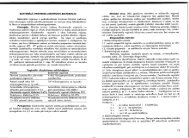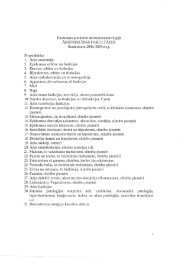PHYSICS
n - susliks.lv
n - susliks.lv
- No tags were found...
Create successful ePaper yourself
Turn your PDF publications into a flip-book with our unique Google optimized e-Paper software.
21.2.2. Laws of Geometric Optics<br />
sin e = n 2<br />
( - n 1<br />
(21.4)<br />
Law of Reflection: When a ray of light is reflected from a plane<br />
surface, the incident ray and the reflected ray all lie in the same<br />
plane; the angle of reflection equals the angle of incidence:<br />
i=r<br />
(21.1)<br />
Law of Refraction: When a ray of light passes from one medium<br />
to another, the incident ray, the reflected ray, and the refracted ray<br />
all lie in the same plane; the sine of the angle of incidence bears a<br />
constant ratio to the sine of the angle of refraction:<br />
sin i / sin r = n<br />
( 21.2 )<br />
t<br />
where n I is greater than n2"<br />
2 1<br />
n 2<br />
Fig. 21.4. Total internal reflection<br />
For angles of incidence<br />
greater than i,<br />
the beam is entirely reflected<br />
at the boundary. In<br />
such a way, total internal<br />
reflection occurs only<br />
when light attempts to move<br />
from a medium ofgiven<br />
index of refraction to<br />
a medium of lower index<br />
of refraction.<br />
The ratio sin i / sin r is known as the refractive index from one<br />
medium to another. It is convenient to define the refractive index<br />
of a medium to be the ratio:<br />
c<br />
n=<br />
V<br />
(21.3 )<br />
where c is the speed of light in a vacuum and, V the speed of<br />
light in a medium.<br />
Here are refraction index values for several common materials<br />
are: air = 1.0003, water = 1.33, glass = 1.52, diamond = 2.42,<br />
lead sulfide = 3.91.<br />
21.2.3. Total Internal Reflection<br />
An interesting effect, called total internal reflection, can occur<br />
when light attempts to move from a medium having given index<br />
of refraction (n) to one having a lower index of refraction (n)<br />
(fig. 21.4). All possible directions of the beam are indicated by rays<br />
1 through 5. At some particular angle of incidence, (i), called<br />
the critical angle, the refracted light ray will move parallel to the<br />
boundary. The value of the critical angle (8) can be found from<br />
the following expression:<br />
142<br />
, ;~<br />
,<br />
Example. Find the critical angle for a water-air boundary (a view from<br />
the fish's eye) if the index of refraction of water is \.33.<br />
Solution. Applying the equation (2\.4), we find the critical angle<br />
to be sine 0= n 1 =_1_ =0 752<br />
c n, 1.33 .<br />
Optical fibers are devices that can be used for transporting<br />
radiation from the source to the sample (e.g., a biological tissue)<br />
for diagnostics, therapy, or surgery. An optical fiber consists of a<br />
long, thin and flexible rod of transparent material. The principle<br />
of the operation of a fiber is based on total internal reflection<br />
that depends on the angle of incidence of the light ray and the<br />
refractive index of the fiber (fig. 21.5). Usually, each fiber consists<br />
three parts: the core at the centre of the fiber; a concentric<br />
Cladding<br />
8 c<br />
= 48.8"<br />
21.2.4. Fiber Optics<br />
... --~--<br />
-----<br />
Fig. 21.5. Principle<br />
of operation of fiber<br />
143






